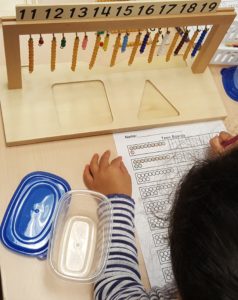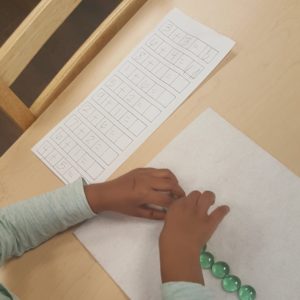Are you looking for ways to teach your child simple addition and subtraction skills?
These easy & simple ideas are perfect for young learners!
I know what you’re thinking…
-
a young preschool child cannot grasp the understanding and meaning behind addition and subtraction.
-
it is not age appropriate or developmentally appropriate for a preschool child to do addition and subtraction.
Well, what if I told you that you are ABSOLUTELY WRONG in your thinking!! Children as young as four are capable of completing simple addition and subtraction problems. It is all in the way it is presented to them and in the language used in the presentation. Remember, presentation is EVERYTHING!! Using the correct language and wording is key in children grasping and understanding the process of “addition” and “subtraction”.
This post may contain affiliate links. I may earn compensation when you click on the links; at no additional cost to you. Please see the disclosure policy for more information.
When addition & subtraction should be introduced
Beginning lessons on simple addition and subtraction can be done once a child has mastered their numbers from one to twenty. When I say master, I mean that if you show them random numbers (out of order) from one to twenty, they should be able to tell you what they are without hesitation. If a child has only mastered numbers one to ten, you can just introduce simple addition and subtraction using numbers one to ten until they have numbers eleven to twenty mastered. It is important to remember that children master knowing numbers and the number quantities, and have experience with counting before introducing these complex operations. The complexity of the lesson depends on the mastery level of the child and the lessons they have had. In these cases, you always follow the child’s development.
The language of “addition” and “subtraction”
The language and wording used when introducing these concepts is important.
The act of addition is to take two sets of number quantities, and add them together. When introducing addition to young children, you should explain it as you take two sets of quantities, add one set to another, and count to see how much they make together. When introducing addition to young children, the key vocabulary words to use are “together”, “add”, and “count”.
The act of subtraction is to take one large number quantity, and taking away a second number quantity. When introducing subtraction to young children, you should explain it as you take one quantity, take away the second quantity, and count to see what is left over. When introducing young children, the key vocabulary words to use are “take away”, “count”, and “left over”
The Montessori Way
If a child has been in a Montessori environment or has been exposed to Montessori materials in some way, then one of the first counting lessons would be the bead stair . The bead stair is a set of beads from one to nine with a colored bead that represents each number. The 1 bead is red, the 2 bead is green, the 3 bead is pink, the 4 bead is yellow, the 5 bead is light blue, the 6 bead is purple, the 7 bead is white, the 8 bead is brown, and the 9 bead is dark blue. The children are encouraged to master recognition of numbers one to nine, as well as the color that corresponds with each number.
Once the one to nine bead stair is mastered, then the child will be introduced to the teen bead stair . The teen bead stair introduces the child to the number 10, which is a golden bead. The golden ten bead is paired with the one to nine colored beads to master numbers eleven to nineteen.
To introduce addition, the double bead stair is used. It is a tray that contains two sets of bead stairs; one to ten. The children use it to complete simple addition problems. I would write out problems in random order, and then have children select the first number(corresponding bead) in the problem from the first bead stair, and the second number(corresponding bead) in the problem from the second bead stair. I would point out that the symbol in the middle of both numbers is a addition sign, and that we will be “adding” the numbers of both beads “together”. I would then have them count all of the beads, and write their answer in the empty box on their paper. The beads are very close together, so I would give them a “bead counter” to use; which is just a bread bag tie broken in half!
The Montessori-inspired way
If a child has not been exposed to the Montessori environment and the materials, then I would introduce counting lessons using Montessori-inspired works and lessons. Montessori-inspired works and lessons are activities that are inspired by and based on Montessori practices and principles, but that are not necessarily authentic Montessori materials. They will still benefit the learning and development of the child, but they do not have a formal Montessori name. An example of a Montessori inspired activity is counting, adding or subtracting with glass beads. You could use almost anything. Glass beads, pennies, rocks, or stringing beads are all good items to use.
Just like in the other lesson, I would write out random addition problems and have them get the correct quantity of counting beads for the first number. I would have them leave a small space, and then have them get the correct quantity of counting beads for the second number. They would then put them together, count them all, and write their answer in the empty box on their paper.
I would always use this Montessori-inspired activity to introduce the children to simple subtraction. I would make sure to point out that the symbol in the middle is different than before; it is a “take away” sign. I again would write out random problems, then have then get the correct quantity of beads for the first number. Then I make it a point to remind them that we are going to “take away” the correct amount of beads for the second number. Then I would instruct them to count what is “left over”. They then would write the answer in the empty box on their paper.
There you have it! It is just that simple! Teaching simple addition and subtraction can be easy if you present it int best way possible, and are conscious of the wording that you use. If you would rather not purchase the Montessori bead stair works and the beads, you can use whatever you have at home. Spare change, small candies, beans; the product you use does not matter. The process of doing the operations of addition and subtraction is what matters. Just have fun with it and let your child learn from the materials you have!
Enjoy!
Anitra J.













My daughter has been trying to grasp the concept of adding, and subtracting on her own, and I just wasn’t sure if that was even possible! She has been playing with a group of objects, taking one away, and then asking how many are left in the pile! Then she counts how many are left. She is only 2.5, and does this all on her own. She can count to 50, and visually identify written numbers from 1 to 20. I try not to push her, to learn things, but she is practically teaching herself! She also tries to teach herself addition by adding up how many fingers she is holding up on each hand.
Holy smokes Michelle! That’s amazing! I would be in heaven if she was in my class!! Since she’s younger, I would just keep doing what you’re doing; not push her to do more than she’s doing. Sometimes the “push” discourages them and they shut down. She is definitely on her way!
Thank you, I’ve never taught kids in her age range before, so this is all new to me. I taught 2nd graders before I became a stay at home mom. I am learning a lot about teaching toddlers through research, and a lot of trial, and error. I just expose her to anything, and everything I can think of, and follow her lead. She is way ahead of anything I ever thought was possible for a two year old. If you look at our blog, you can tell we have fun with so many different activities. Being a mom has definitely taught me how to be a better teacher.
So cool! Feel free to use any ideas I have on my blog for your teaching s with your daughter. I try to put an assortment of ideas that range from science, reading, writing, math and more!
Great tips! I am going to try the glass bead method for my daughter. I had never even heard of a bead stair before, how neat!
Hi Kristin! The glass beads are great. I get them from the Dollar Tree! The bead stair is a traditional Montessori material, so unless you’re familiar with the Montessori method and materials, it’s not something you hear about on a regular basis!
I am looking forward to trying this with my 4 year old. Thank you for sharing these tips and technique with others!
You’re welcome Niki! Oh great, I hope she enjoys the hands on aspect of this technique!
These are such great methods for teaching addition and subtraction! I have worked with 4 year olds on this skill and you are right it truly is about how you present it to them and having visuals! I am excited to try this way out next time.
This is great information! I love the how the montessori approach uses so many manipulative. Thanks!
I totally agree with you when you say that is possible to teach the idea of attraction e subtraction even when the kids are really young.
These are great tips. My son has ADHD so at times it feels like a struggle.
If a child is ready to learn, they are ready to learn. It’s not always an age thing. You’re not going to traumatize a child by exposing them to the concepts of addition and subtraction. You have it all laid out in the methods in this post. It’s easy to understand the concepts. I am an elementary teacher and it so depends on the situation and the child.
The glass gems and the beads ideas. Both will work. Thanks for the tips
I used to work in a Montessori based daycare, and it’s amazing how young kids are able to pick up on math concepts using the Montessori equipment..
Great tips on teaching addition and subtraction! Thanks for sharing! I love the glass beads.
Thanks for sharing. The bead stair project seems like a perfect introductions to numbers for addition and subtraction! Will definitely try that one 👌🏻
My little one just turned two and she’s counting to ten, knows the alphabet and is stringing some sentences together. We really want to start teaching her addition but she gets distracted very easily and just starts doing something else. Too soon maybe?
That’s amazing Michelle! I would say yes, it’s too soon. I would focus on counting, number recognition and introduce letter sounds.
I love the Montessori philosophy. The simplicity is refreshing. You don’t need complicated tools or resources! This is a really great resource. Thank you so much for sharing!
This is amazing! Especially with a lot of kids home schooling these days, this is very helpful
These look like fun ways to teach my little the concept of addition and subtraction. Thank you so much for sharing!
Great information. As a former KG teacher, I know children are like sponges and they soak up and learn more than adults believe they are capable of doing and learning. Very good tips.
I have been trying some of these that you recommended and it’s really amazing what kids can do with the right instruction!
This is such an interesting way to teach addition and subtraction. Need to look more at the Montessori way of teaching skills
This looks like a really fun and inspiring way to learn
I’m definitely going to save this and keep it for next year!
These are some fun and effective ways to teach kids to add and subtract! Making it fun makes a difference